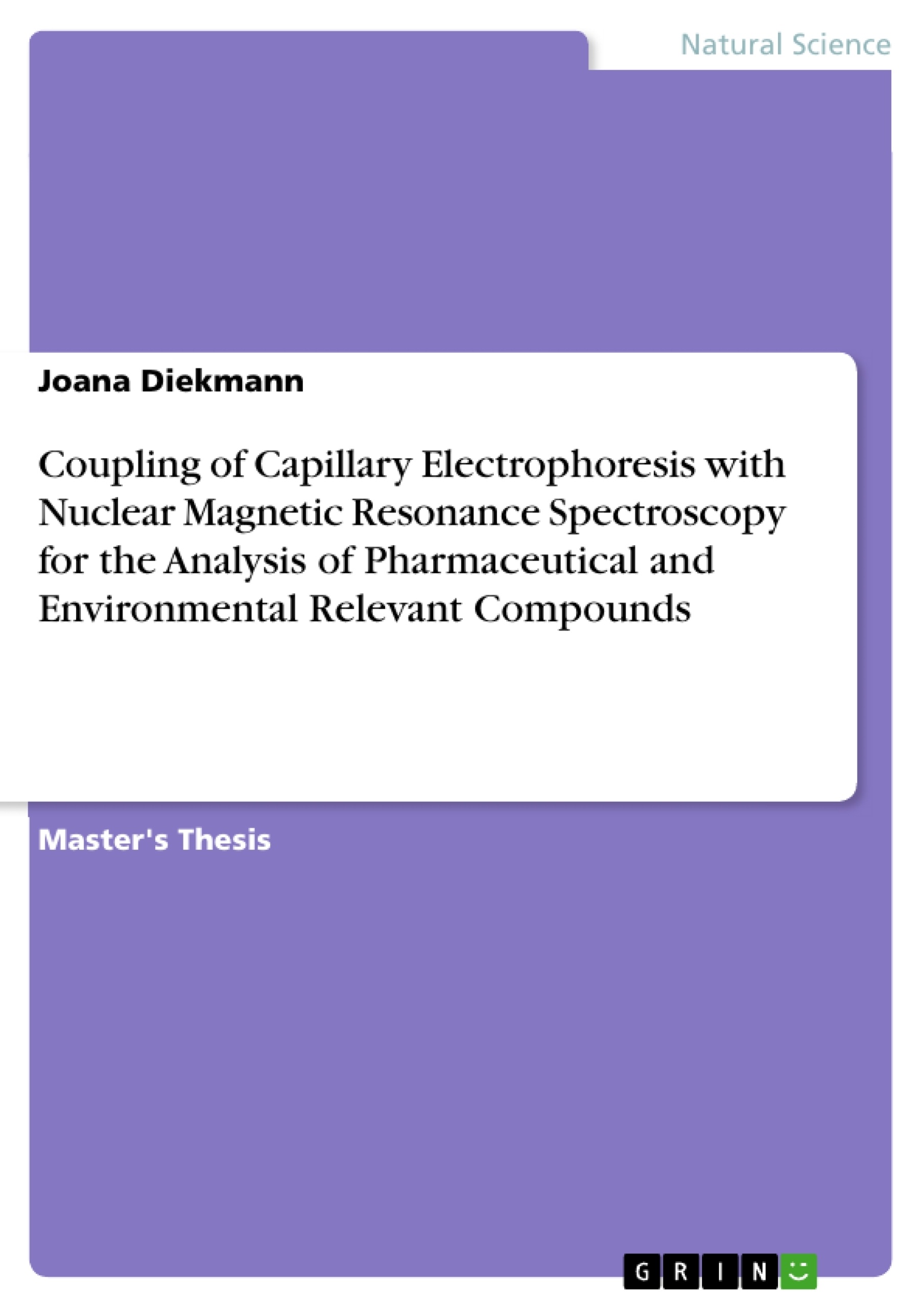
Coupling of Capillary Electrophoresis with Nuclear Magnetic Resonance Spectroscopy for the Analysis of Pharmaceutical and Environmental Relevant Compounds
Masterarbeit, 2009
107 Seiten, Note: 1,0
Leseprobe
Inhaltsverzeichnis (Table of Contents)
- Abstract
- Zusammenfassung
- Acknowledgement
- Introduction
- Theoretical Background
- Capillary Electrophoresis (CE)
- Nuclear Magnetic Resonance (NMR) Spectroscopy
- Principles of NMR Spectroscopy
- NMR Detection Techniques
- Microcoil NMR
- Coupling CE to NMR Spectroscopy
- On-Line CE-NMR
- Experimental Section
- Chemicals and Materials
- Instrumentation and Methods
- Large-Scale 'H NMR System
- Portable 'F NMR System
- CE-NMR System
- Sample Preparation
- Results and Discussion
- Large-Scale 'H NMR Experiments
- Portable 'F NMR Experiments
- CE-NMR Experiments
- Data Analysis and Evaluation
- Conclusions
Zielsetzung und Themenschwerpunkte (Objectives and Key Themes)
This Master thesis explores the potential of coupling capillary electrophoresis (CE) with nuclear magnetic resonance (NMR) spectroscopy for the analysis of pharmaceutical and environmental relevant compounds. The main objective is to investigate the feasibility and advantages of using a portable NMR system coupled to CE for on-site and high-throughput identification of analytes in small sample volumes.
- Integration of CE and NMR for efficient analyte separation and identification
- Exploration of portable NMR systems for on-site analysis
- Development of methods for analyzing pharmaceutical and environmental compounds
- Enhancement of sensitivity and throughput in analytical techniques
- Optimization of experimental parameters for CE-NMR coupling
Zusammenfassung der Kapitel (Chapter Summaries)
- The Introduction provides an overview of the research topic and the significance of coupling CE to NMR spectroscopy for analyzing pharmaceutical and environmental samples. It highlights the importance of miniaturization and portability in NMR technology for on-site analysis.
- The Theoretical Background section delves into the fundamental principles of CE and NMR spectroscopy, including the various detection techniques used in NMR. It also explores the advantages of microcoil NMR for increasing sensitivity and the concept of on-line CE-NMR coupling.
- The Experimental Section details the chemicals, materials, and instrumentation used in the research. It describes the large-scale 'H NMR system, the portable 'F NMR system, and the CE-NMR system employed in the experiments. Sample preparation procedures are also outlined.
- The Results and Discussion chapter presents the findings of the experiments, focusing on the results obtained with the large-scale 'H NMR system, the portable 'F NMR system, and the CE-NMR system. The analysis and evaluation of the data are discussed, highlighting the advantages and limitations of the various techniques.
Schlüsselwörter (Keywords)
This research focuses on the coupling of capillary electrophoresis (CE) with nuclear magnetic resonance (NMR) spectroscopy, particularly with portable 'F NMR systems, for the analysis of pharmaceutical and environmental compounds. Key topics include microcoil NMR, on-line CE-NMR, perfluorinated carboxylic acids, trifluoroacetic acid, xanthine, and uric acids. The study aims to demonstrate the feasibility and advantages of this hyphenated analytical technique for high-throughput, on-site analysis of small sample volumes.
Details
- Titel
- Coupling of Capillary Electrophoresis with Nuclear Magnetic Resonance Spectroscopy for the Analysis of Pharmaceutical and Environmental Relevant Compounds
- Hochschule
- Gottfried Wilhelm Leibniz Universität Hannover (Anorganische Chemie)
- Note
- 1,0
- Autor
- Joana Diekmann (Autor:in)
- Erscheinungsjahr
- 2009
- Seiten
- 107
- Katalognummer
- V169088
- ISBN (eBook)
- 9783640873395
- ISBN (Buch)
- 9783640873593
- Dateigröße
- 7557 KB
- Sprache
- Englisch
- Anmerkungen
- This Master Thesis was awarded with the "E.ON Future Award 2010" and it was carried out at the Leibniz University Hannover, Faculty of Natural Sciences, Institute for Inorganic Chemistry, Department of Analytical Chemistry, in cooperation with the Lawrence Livermore National Laboratory, Physical and Life Sciences Directorate, Livermore, CA, USA.
- Schlagworte
- Capillary Electrophoresis Microcoil 1H NMR Portable 19F NMR On-Line CE- NMR Perfluorinated Carboxylic Acids Trifluoroacetic Acid Xanthine Uric Acids
- Produktsicherheit
- GRIN Publishing GmbH
- Preis (Ebook)
- US$ 39,99
- Preis (Book)
- US$ 50,99
- Arbeit zitieren
- Joana Diekmann (Autor:in), 2009, Coupling of Capillary Electrophoresis with Nuclear Magnetic Resonance Spectroscopy for the Analysis of Pharmaceutical and Environmental Relevant Compounds, München, Page::Imprint:: GRINVerlagOHG, https://www.diplomarbeiten24.de/document/169088
- Autor werden
- Ihre Optionen
- Vertriebskanäle
- Premium Services
- Autorenprofil
- Textarten und Formate
- Services für Verlage, Hochschulen, Unternehmen

- © GRIN Publishing GmbH.
- Alle Inhalte urheberrechtlich geschützt. Kopieren und verbreiten untersagt.
- info@grin.com
- AGB
- Open Publishing
Der GRIN Verlag hat sich seit 1998 auf die Veröffentlichung akademischer eBooks und Bücher spezialisiert. Der GRIN Verlag steht damit als erstes Unternehmen für User Generated Quality Content. Die Verlagsseiten GRIN.com, Hausarbeiten.de und Diplomarbeiten24 bieten für Hochschullehrer, Absolventen und Studenten die ideale Plattform, wissenschaftliche Texte wie Hausarbeiten, Referate, Bachelorarbeiten, Masterarbeiten, Diplomarbeiten, Dissertationen und wissenschaftliche Aufsätze einem breiten Publikum zu präsentieren.
Kostenfreie Veröffentlichung: Hausarbeit, Bachelorarbeit, Diplomarbeit, Dissertation, Masterarbeit, Interpretation oder Referat jetzt veröffentlichen!
- GRIN Verlag GmbH
-
- Nymphenburger Str. 86
- 80636
- Munich, Deutschland
- +49 89-550559-0
- +49 89-550559-10
- info@grin.com
-










Kommentare